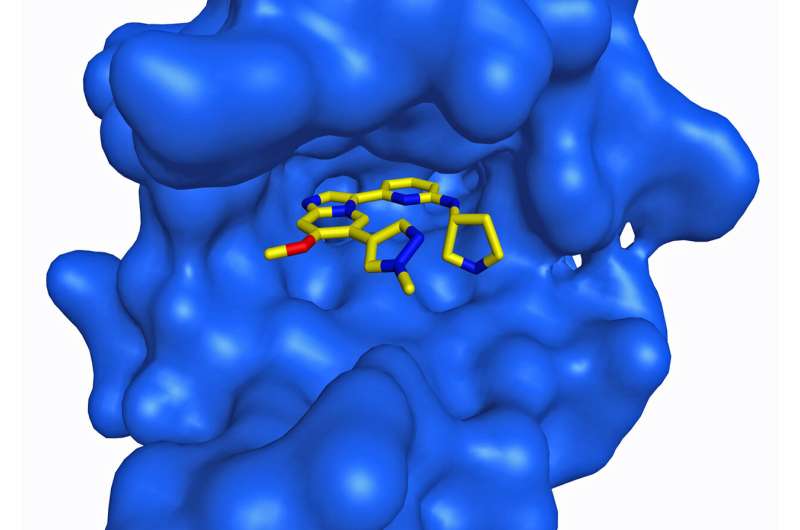Scientists develop possible strategy for cancer drug resistance

Scientists from the National Institutes of Health and Cincinnati Children's Hospital Medical Center have devised a potential treatment against a common type of leukemia that could have implications for many other types of cancer. The new approach takes aim at a way that cancer cells evade the effects of drugs, a process called adaptive resistance.
The researchers, in a range of studies, identified a cellular pathway that allows a form of acute myeloid leukemia (AML), a deadly blood and bone marrow cancer, to elude the activity of a promising class of drugs. They then engineered a compound that appears to launch a two-pronged attack against the cancer. In several experiments, the compound blocked a mutant protein that causes the AML. At the same time, it halted the cancer cells' ability to sidestep the compound's effects. The results, reported Sept. 4 in Science Translational Medicine, could lead to the development of new therapies against AML and cancers that act in similar ways.
Co-corresponding authors Daniel Starczynowski, Ph.D., at Cincinnati Children's, Craig Thomas, Ph.D., at NIH's National Center for Advancing Translational Sciences (NCATS) and their colleagues wanted to better understand drug resistance in a form of AML caused by a mutant protein called FLT3. This form of AML accounts for roughly 25% of all newly diagnosed AML cases, and patients often have a poor prognosis. A more thorough understanding of the drug resistance process could help them find ways to improve therapy options.
FLT3 belongs to a class of enzymes called kinases. Kinases are proteins that play a role in cell growth and proliferation. When kinases work overtime, they can cause some cancers. Drugs that block kinase activity have been effective in treating cancers. While many of these drugs work initially, often in combination with other therapies, cancer cells frequently find ways to bypass the drugs' effects and begin growing again. For many patients, this drug resistance can be deadly. FLT3 is always turned on in these cancer cells, sending chemical signals for the cells to grow and divide. Scientists have designed drugs to block FLT3 activity, but the AML cells eventually find ways to get the growth signals elsewhere.
To find out how this happens, Starczynowski's team treated FLT3-mutant cancer cells grown in the laboratory with an inhibitor drug. The drug initially killed many cancer cells. The scientists closely examined the AML cells that survived, including genes that were turned on and off in the resistant cells. They found that the leukemia cells were now getting chemical growth signals from different protein kinases through a system normally used by the immune system to respond to viruses and other invaders. Experiments on AML cells from patients treated with a FLT3 inhibitor showed similar results.
"We think that these leukemia cells were under stress from the FLT3 inhibitor drug because it was blocking the growth signals they badly wanted," Starczynowski said. "The cells found another way to get these signals through another route that compensated for this, a complex of the kinases IRAK1 and IRAK4, which are involved in the immune system."
To prove their theory, the scientists, in a series of experiments on leukemia cell models in the lab and cells from leukemia patients, showed that inhibiting FLT3 and IRAK1-IRAK4 activity at the same time was more toxic to cells relative to only inhibiting FLT3.
To prevent this drug resistance, the NCATS team worked to block the activity of FLT3 and the IRAK kinases with a single compound. Starting with an IRAK4 inhibitor, they developed a compound that was effective against all three protein kinases. These efforts led to a new compound, NCGC1481, that could effectively block the activity of the kinases in both human cancer cells in the lab and mouse models with cancer cells from patients. (NCGC is an acronym for the NCATS Chemical Genomics Center.)
"NCGC1481 not only stops the cancer cells' growth caused by the mutant protein, but also blocks the cancer's escape route," said first author Katelyn Melgar, Ph.D. "The result is a compound with superior activity in the models we tested."
The findings may be broadly applicable to many other cancers as well. "There is already evidence that this may be a general cancer resistance mechanism to protein kinase inhibitor drugs," Starczynowski said. "In theory, the use of drugs that affect many kinases at once, along with other kinds of cancer therapies, could be effective treatments."
For now, NCGC1481 is still a work in progress.
"Kinase inhibitor development aims to thread a needle between targets that are important, such as FLT3 and IRAK1-IRAK4, and targets that aren't," said Thomas. "We're still working on a final product that we hope can advance to clinical testing."
More information: K. Melgar el al., "Overcoming adaptive therapy resistance in AML by targeting immune response pathways," Science Translational Medicine (2019). stm.sciencemag.org/lookup/doi/ … scitranslmed.aaw8828


















